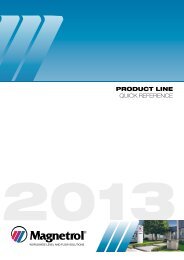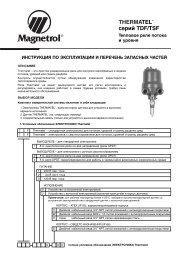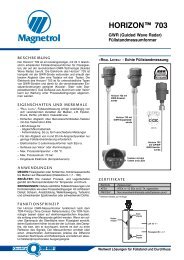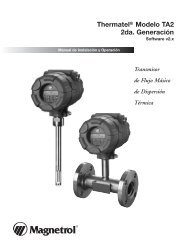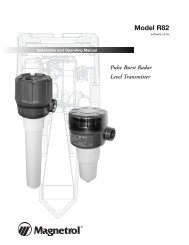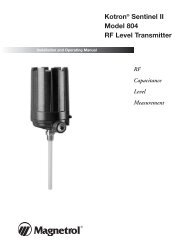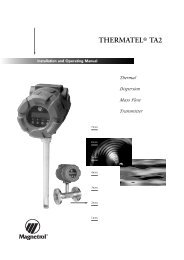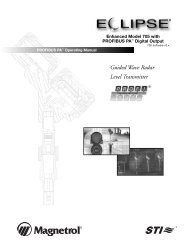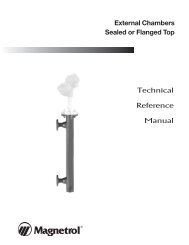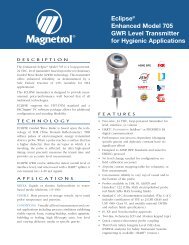Instruction Manual - Magnetrol International
Instruction Manual - Magnetrol International
Instruction Manual - Magnetrol International
Create successful ePaper yourself
Turn your PDF publications into a flip-book with our unique Google optimized e-Paper software.
Periodic inspections are a necessary means to keep your <strong>Magnetrol</strong> level control in good working order. This control<br />
is, in reality, a safety device to protect the valuable equipment it serves. Therefore, a systematic program of<br />
“Preventive Maintenance” should be implemented when control is placed into service. If the following sections on<br />
“What to Do” an “What to Avoid” are observed, your control will provide reliable protection of your capital equipment.<br />
WHAT TO DO<br />
1. Keep Control Clean<br />
Be sure the switch housing cover is always in place on<br />
the control. This cover is designed to keep dust and dirt<br />
from interfering with switch mechanism operation. In<br />
addition, it protects against damaging moisture and<br />
acts as a safety feature by keeping bare wires and terminals<br />
from being exposed. Should the housing cover<br />
become damaged or misplaced, order a replacement<br />
immediately.<br />
2. Inspect Switch Mechanisms, Terminals and<br />
Connections Monthly<br />
–Mercury switches may be visually inspected for short<br />
circuit damage. Check for small cracks in the glass<br />
tube containing the mercury. Such cracks can allow<br />
entrance of air into the tube causing the mercury to<br />
“oxidize”. This is noticeable as the mercury will<br />
appear dirty and have a tendency to “string out” like<br />
water, instead of breaking into clean round pools. If<br />
these conditions exist, replace the mercury switch<br />
immediately.<br />
–Dry contact switches should be inspected for excessive<br />
wear on actuating lever or misalignment of<br />
adjusting screw at point of contact between screw<br />
and lever. Such wear can cause false switch actuating<br />
levels. Adjust switch mechanism to compensate<br />
(if possible) or replace switch.<br />
4<br />
WIRING (cont.)<br />
OBSERVE ALL APPLICABLE ELECTRICAL CODES AND PROPER WIRING PROCEDURES<br />
NEMA 4x<br />
NEMA 7/9<br />
Set screw<br />
Set screw<br />
Figure 4a<br />
Set screw<br />
Position<br />
screw<br />
Figure 4b<br />
CENELEC/BASEEFA<br />
Locking screw<br />
PREVENTIVE MAINTENANCE<br />
Figure 4c<br />
CAUTION:<br />
- DO NOT attempt to reposition NEMA 4 /<br />
NEMA 7/9 housings without loosening the<br />
set screws; CENELEC/BASEEFA housings<br />
MAY NOT BE REPOSITIONNED. ALWAYS<br />
retighten set screw(s) after repositionning.<br />
- DO NOT attempt to unscrew cover of CEN-<br />
ELEC/BASEEFA housings before loosening<br />
locking screw in base of housing. ALWAYS<br />
retighten locking screw after replacing cover.<br />
DO NOT operate your control with defective maladjusted<br />
switch mechanisms (refer to bulletin on switch mechanism<br />
furnished for service instructions).<br />
–<strong>Magnetrol</strong> controls may sometimes be exposed to<br />
excessive heat or moisture. Under such conditions,<br />
insulation on electrical wires may become brittle,<br />
eventually breaking or peeling away. The resulting<br />
“bare” wires can cause short circuits. Check wiring<br />
carefully and replace at first sign of brittle insulation.<br />
–Vibration may sometimes cause terminal screws to<br />
work loose. Check all terminal connections to be certain<br />
that screws are tight.<br />
–On units with pneumatic switches, air (or gas) operating<br />
medium lines subjected to vibration, may eventually<br />
crack or become loose at connections causing<br />
leakage. Check lines and connections carefully and<br />
repair or replace, if necessary.<br />
NOTE: As a matter of good practice, spare switches should<br />
be kept on hand at all times.<br />
3. Inspect Entire Unit Periodically<br />
Isolate control from vessel. Raise and lower liquid level<br />
to check for switch contact and reset.



